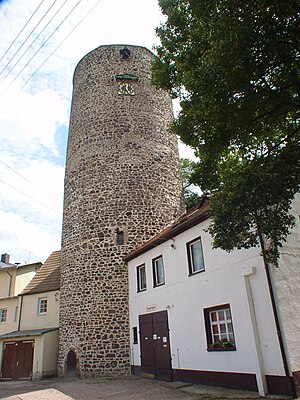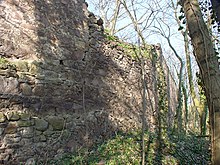Krosigk Castle
| Krosigk Castle | ||
|---|---|---|
|
Keep |
||
| Creation time : | around 1100 | |
| Castle type : | Location | |
| Conservation status: | Keep | |
| Standing position : | Nobles, clericals | |
| Place: | Krosigk | |
| Geographical location | 51 ° 36 '34 " N , 11 ° 56' 5.1" E | |
| Height: | 176 m above sea level NHN | |
|
|
||
Krosigk Castle is a ruined castle at about 176 m above sea level. NHN in the locality of Krosigk , municipality Petersberg in the Saalekreis in Saxony-Anhalt . The castle is a small ministerial castle. The keep from the 12th century, remains of the curtain wall and the remains of the very wide moat have been preserved. All other medieval buildings were built over in later epochs.
history
The origin of the castle is associated with Dedo von Krosigk (Teto de Crozuc) , who came from the Franconian nobility (see Krosigk (noble family) ). This appears for the first time in a document of the Naumburg bishop Walram 1103 as a witness. The importance of Dedo becomes clear when one considers a historical event.
Wiprecht von Groitzsch the Younger, leader of the Saxon aristocratic opposition to Emperor Heinrich V , found refuge on Dedo’s estates in 1115 when he was persecuted for his opposition. From this it can be concluded that Dedo must have had an influence in the environment of the imperial court that should not be underestimated. The noble family was probably related to the opposing king Hermann von Salm , whose followers included Wiprecht.
The massive parts of the castle may have been built around the first mention of Dedo. References to older fortifications have not yet been found.
The von Krosigk family also had a great influence on imperial politics in the 13th century. Konrad von Krosigk was elected Bishop of Halberstadt in 1201 . He was a leader in the Fourth Crusade and had a great influence on the decision of the Crusaders to conquer Constantinople , where it came to the fight of Christians against Christians.
In 1207 Konrad's brother, Friedrich von Krosigk, sold some goods in Krosigk for 25 marks to the Archbishop of Magdeburg Albrecht.
In the further course of the 13th century, the importance of the noble family declined. In 1260 they are mentioned as feudal bearers of Count Dietrich von Brehna . The genus must have died out around 1280. The counts then installed ministerials from their own followers in the rule. The lords of Garsena, a Burgmann family , took the name of their new seat as their family name just a few years later and founded the noble branch of the von Krosigk family. He sat in the castle until the 15th century. (The family history of those from Krosigk and the gentlemen from the Winckel of the same tribe, on the other hand, assumes a continuity of the noble-free sex .).
After the Count of Brehna died out in 1290, the Ascanian Duke of Saxony became feudal lord. In 1308 he designated the castle as his sister's marriage property. Her husband, Friedrich von Meißen, pledged her to Heinrich von Köckeritz. After many other pledges, the rule finally came to the Archbishopric of Magdeburg in the 14th century .
From 1421 the von Trotha family appeared as buyers of individual goods in the Krosigk estate. From 1423 to 1439 and from 1444 to 1451 the Winckel family held the castle as a fief. In 1451, the Archbishop's High Marshal Thilo von Trotha and his brother Hermann were enfeoffed with the castle by the Archbishop of Magdeburg Günther. The later marshal of the Electorate of the Palatinate and Lord of Berwartstein Castle in the southern Palatinate, Hans von Trotha or, as they say in the Palatinate vernacular, Hans Trapp, is said to have been born around 1450. Until 1813 the family owned the manor in Krosigk.
On October 23, 1644 the castle was destroyed by the Swedes . It is not known when the reconstruction took place. In 1701 Wolf Friedrich von Trotha built the manor house on the grounds of the outer bailey and in 1703 the chapel. In 1813 the von Trotha family had to sell the indebted property.
In the 19th and 20th centuries the buildings were used by farms.
After years of use by the LPG and as a daycare center, the facility now belongs to the community and is freely accessible. The tower can be climbed for the village festival on the 2nd weekend in June every year.
literature
- Michael Hecht: The noble lords of Krosigk - A Central German noble family in the 12th and 13th centuries, in: Hallische contributions to the historical auxiliary sciences, Issue 1, Halle 1998
- Paul Grimm: The prehistoric and early historical castle walls of the districts of Halle and Magdeburg, Akademie-Verlag, Berlin, 1958
- Georg Dehio , Handbook of Art Monuments, The Halle District, Akademie-Verlag, Berlin 1976
- Handbook of the historical sites of Germany, Province of Saxony-Anhalt, Alfred Kröner Verlag, Stuttgart 1987.
Web links
- Krosigk Castle at burgenwelt.de
- Material on Burg Krosigk in the Duncker collection of the Central and State Library Berlin





